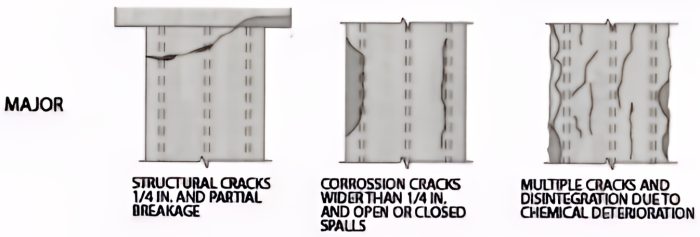The following is from the American Society of Civil Engineers (ASCE)
MINOR DAMAGE
- Mechanical abrasion or impact spalls up to 1-inch in depth;
- Occasional corrosion stains or small pop-out corrosion spalls;
- Surface cracks up to 1/16-inch in width.
 MODERATE DAMAGE
MODERATE DAMAGE
- Structural damage;
- Structural cracks up to 1/16-inch in width;
- Corrosion cracks up to 1/4-inch wide;
- Chemical deterioration (Sulfate attack, alkali-silica reaction, alkali-aggregate reaction, alkali-carbonate reaction, delayed ettringite formation).
- Chemical deterioration: random cracks up to 1/16-inch in width;
- Soft concrete or rounding of corners up to 1-inch deep;
- Mechanical abrasion or impact spalls greater than 1-inch in depth.
NOTE: Identifying specific types of chemical deterioration (such as those listed above) exceeds the scope of this inspection. Links are provided as a reference only.
 MAJOR DAMAGE
MAJOR DAMAGE
- Structural cracks 1/16-inch to 1/4-inch in width and partial breakage (through section cracking with structural spalls);
- Corrosion cracks wider than ¼-inch and open or closed corrosion spalls (excluding pop-outs);
- Multiple cracks and disintegration of the surface layer due to chemical deterioration;
- Mechanical abrasion or impact spalls exposing the rebar.
- Structural breakage and/or spalls;
- Exposed rebar;
- Loss of cross section due to chemical deterioration beyond rounding of corner edges.
 SEVERE DAMAGE
SEVERE DAMAGE
- Structural cracks wider than 1/4-inch or complete breakage;
- Complete loss of concrete cover due to corrosion of rebar with more than 30% of loss for any main reinforcing steel (rebar);
- Loss of bearing and/or displacement at connections;
- Loss of concrete cover (exposed rebar) due to chemical deterioration;
- Loss of more than 30% of cross section due to any cause.

